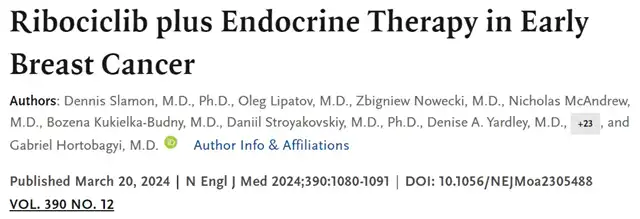Ribociclib Combo Reduces Recurrence Risk in Early Breast Cancer
- Normal Liver Cells Found to Promote Cancer Metastasis to the Liver
- Nearly 80% Complete Remission: Breakthrough in ADC Anti-Tumor Treatment
- Vaccination Against Common Diseases May Prevent Dementia!
- New Alzheimer’s Disease (AD) Diagnosis and Staging Criteria
- Breakthrough in Alzheimer’s Disease: New Nasal Spray Halts Cognitive Decline by Targeting Toxic Protein
- Can the Tap Water at the Paris Olympics be Drunk Directly?
Ribociclib Combo Reduces Recurrence Risk in Early Breast Cancer
- Should China be held legally responsible for the US’s $18 trillion COVID losses?
- CT Radiation Exposure Linked to Blood Cancer in Children and Adolescents
- FDA has mandated a top-level black box warning for all marketed CAR-T therapies
- Can people with high blood pressure eat peanuts?
- What is the difference between dopamine and dobutamine?
- How long can the patient live after heart stent surgery?
Ribociclib Combo Reduces Recurrence Risk in Early Breast Cancer
Reduced Risk of Recurrence or Death by 25.2%! NEJM Publishes Results of New Strategy for “Most Common” Breast Cancer.
Hormone receptor (HR)-positive, human epidermal growth factor receptor 2 (HER2)-negative breast cancer is the “most common” subtype, accounting for 70% to 75% of breast cancer cases. Most cases of this subtype are diagnosed in the early stages of the disease (Stages 1-3). Adjuvant endocrine therapy can improve the prognosis of these patients. However, 27% to 37% of Stage 2 patients and 46% to 57% of Stage 3 patients experience recurrence.
Ribociclib is a selective cyclin-dependent kinase 4/6 (CDK4/6) inhibitor. Studies have shown that this type of therapy provides significant overall survival benefit for patients with HR-positive, HER2-negative advanced breast cancer, but its benefit for advanced breast cancer may not extend to early breast cancer.
The New England Journal of Medicine recently published the results of a pre-specified interim analysis of the NATALEE trial, which showed that ribociclib in combination with a non-steroidal aromatase inhibitor (NSAI) significantly improved the invasive disease-free survival (iDFS) of Stage 2 or 3 early breast cancer patients who were HR-positive and HER2-negative (ribociclib + NSAI group vs. NSAI alone group = 90.4% vs. 87.1%).

This international, open-label, randomized, Phase 3 trial was conducted from January 10, 2019, to April 20, 2021, and included 5,101 early breast cancer patients with Stage 2 or 3 HR-positive, HER2-negative disease, who were randomly assigned in a 1:1 ratio to receive ribociclib (400 mg daily for 3 weeks, followed by 1 week off, for a total of 3 years) + endocrine therapy (NSAI; letrozole 2.5 mg/day or anastrozole 1 mg/day for ≥5 years) or NSAI alone. The primary endpoint was iDFS. Secondary endpoints included distant disease-free survival, recurrence-free survival, overall survival, safety, and pharmacokinetics. The data analysis cutoff date was January 11, 2023.
The two groups were similar in demographic and baseline clinical characteristics. As of the data cutoff date, a total of 426 patients experienced invasive disease, recurrence, or death.
At 3 years, the iDFS rate was 90.4% in the ribociclib + NSAI group and 87.1% in the NSAI alone group. Compared to NSAI alone, the combination of ribociclib + NSAI reduced the risk of recurrence or death by 25.2% (risk ratio for invasive disease, recurrence, or death was 0.75; 95% CI 0.62-0.91). The ribociclib + NSAI group showed statistically significant and clinically meaningful efficacy, with a two-sided P value of 0.003, exceeding the pre-specified threshold of 0.0256.
Several secondary efficacy endpoints also showed consistent benefits with ribociclib.
At 3 years, the distant disease-free survival rate was 90.8% in the ribociclib + NSAI group and 88.6% in the NSAI alone group (risk ratio for distant disease or death was 0.74; 95% CI 0.60-0.91).
At 3 years, the recurrence-free survival rate was 91.7% in the ribociclib + NSAI group and 88.6% in the NSAI alone group (risk ratio for disease recurrence or death was 0.72; 95% CI 0.58-0.88).
The median follow-up time for overall survival was 30 months. As of the data cutoff date, there were 61 deaths (2.4%) among the 2,549 subjects in the ribociclib + NSAI group and 73 deaths (2.9%) among the 2,552 subjects in the NSAI alone group (risk ratio for death was 0.76; 95% CI 0.54-1.07).
In terms of safety analysis, 2,470 patients (97.9%) in the ribociclib + NSAI group and 2,128 patients (87.1%) in the NSAI alone group experienced at least one adverse event. The proportion of patients who discontinued NSAI due to any cause or adverse event was similar between the two groups. The most common adverse events of any grade were neutropenia, arthralgia, and liver-related events. The 3-year treatment with ribociclib + NSAI was not associated with any new safety signals.
In pharmacokinetic analysis, the mean trough plasma concentration of ribociclib at steady state was 289.5 ng/mL on Day 15 of Cycle 1. Based on this finding and previous reports, researchers estimated that ribociclib achieved nearly 80% inhibition of CDK4/6 at the average steady-state trough concentration. This suggests that ribociclib can maintain over 80% target inhibition throughout the treatment period.
In summary, this pre-specified interim analysis showed that in patients with Stage 2 or 3 HR-positive, HER2-negative early breast cancer, ribociclib + NSAI treatment significantly reduced the risk of iDFS, recurrence, or death compared to NSAI alone. The 3-year absolute benefit of ribociclib + NSAI was 3.3%. These results support the use of ribociclib in the treatment of HR-positive, HER2-negative early breast cancer.
Ribociclib Combo Reduces Recurrence Risk in Early Breast Cancer
Reference:
[1] Slamon D, et al., (2024). Ribociclib plus Endocrine Therapy in Early Breast Cancer. N Engl J Med, doi: 10.1056/NEJMoa2305488.
(source:internet, reference only)
Disclaimer of medicaltrend.org
Important Note: The information provided is for informational purposes only and should not be considered as medical advice.



